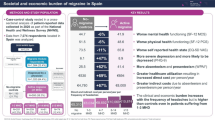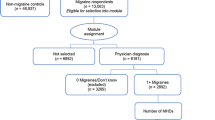Abstract
Objective: To compare self-reported healthcare resource utilisation, paid work loss, unpaid work loss and loss of effectiveness at work due to migraine in a clinic-based adult migraine population.
Methods: The Migraine Background Questionnaire© (MBQ) was translated and pilot-tested for use in 25 countries. The questionnaire was then self-administered by patients at a screening visit for 3 phase III clinical trials of rizatriptan [a selective serotonin (5-hydroxytryptamine) 5-HT1B/1Dreceptor agonist] in 23 US and 78 non-US sites.
Participants: Persons 18 to 65 years of age with at least a 6-month history of moderate to severe migraines prior to the screening visit were surveyed.
Results: A total of 2670 persons (54.7% Europe, 16.5% Latin America, 23.1% North America, 5.5% other countries) completed the MBQ and had responses which could be analysed. On average, each patient reported 2.78 doctor visits, 0.53 emergency room visits and 0.06 hospitalisations related to migraine per year. Patients self-reported being only 46% effective while on the job with migraine symptoms. Extrapolation of patient self-reported work and productivity loss for the last 4 weeks to an annual basis suggested that clinic-based patients with migraine lose 19.5 workday equivalents (8.3 days due to absenteeism, 11.2 days due to reduced workday equivalents) due to migraine per year. In the US, the annual employer cost of this total migraine-related work loss is estimated to be $US3309 (2000 values) per patient with migraine. The levels of self-reported healthcare resources utilised for migraine and work loss were generally consistent across geographic regions.
Conclusions: The impact of migraine symptoms on healthcare resource utilisation and work loss was similar across most measures in Europe, Latin America, North America and other countries. Total migraine-related work loss due to absenteeism and reduced workday equivalents accounts for most of the economic burden of migraine, regardless of country, in a clinic-based migraine population.











Similar content being viewed by others
References
Osterhaus J, Gutterman DL, Plachetka JR. Healthcare resource and lost labour costs of migraine headache in the US. Pharmacoeconomics 1992; 2 (1): 67–76
Reilly MC, Zbrozek AS, Dukes EM. The validity and reproducibility of a work productivity and activity impairment instrument. Pharmacoeconomics 1993; 4 (5): 353–65
Effron B, Tibshirani RJ. An introduction to the bootstrap. New York (NY): Chapman and Hall/CRC, 1993
De Lissovoy G, Lazarue SS. The economic cost of migraine — present state of knowledge. Neurology 1994; Suppl. 4: S56–62
United States employer costs for employee compensation — March 2000. Washington, DC: United States Department of Labor, Bureau of Labor Statistics, 2000 Jun
Hu XH, Markson LE, Lipton RB, et al. Burden of migraine in the United States: disability and economic costs. Arch Intern Med 1999; 159: 813–8
Davies GM, Santanello N, Gerth W, et al. Validation of a migraine work and productivity loss questionnaire for use in migraine studies. Cephalalgia 1999; 19: 497–502
Gold MR, Siegel JE, Russel LB, et al. Cost-effectiveness in health and medicine. New York (NY): Oxford University Press, 1996: 202
Lerner D, Amick III BC, Malspeis S, et al. The migraine work and productivity loss questionnaire: concepts and design. Q Life Res 1999; 8 (8): 699–710
Stewart WF, Shechter A, Rasmussen BK. Migraine prevalence — a review of population-based studies. Neurology 1994; 44 Suppl. 4: S17–23
Pryse-Phillips W, Findlay H, Tugwell R, et al. A Canadian population survey on the clinical, epidemiologic and societal impact of migraine and tension-type headache. Can J Neurol Sci 1992; 19: 333–9
Lipton RB, Stewart WF. Migraine in the United States: a review of epidemiology and health card use. Neurology 1993; 43 Suppl. 3: S6–S10
Schwartz BS, Stewart WF, Lipton RB. Lost workdays and decreased work effectiveness associated with headache in the workplace. J Occup Environ Med 1997; 39: 320–7
Acknowledgements
Supported by Merck & Co., Inc., New Jersey, USA.
Author information
Authors and Affiliations
Corresponding author
Rights and permissions
About this article
Cite this article
Gerth, W.C., Carides, G.W., Dasbach, E.J. et al. The Multinational Impact of Migraine Symptoms on Healthcare Utilisation and Work Loss. Pharmacoeconomics 19, 197–206 (2001). https://doi.org/10.2165/00019053-200119020-00006
Published:
Issue Date:
DOI: https://doi.org/10.2165/00019053-200119020-00006




